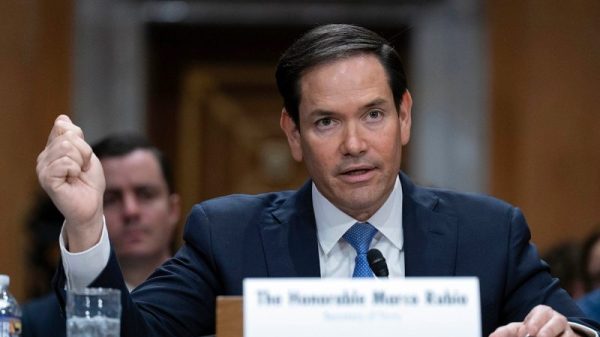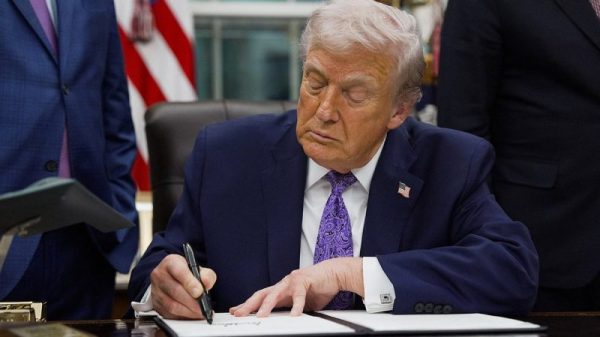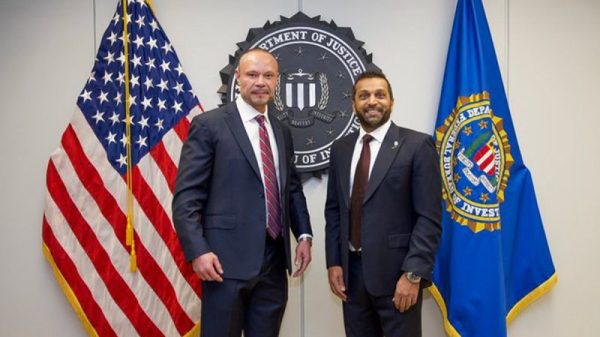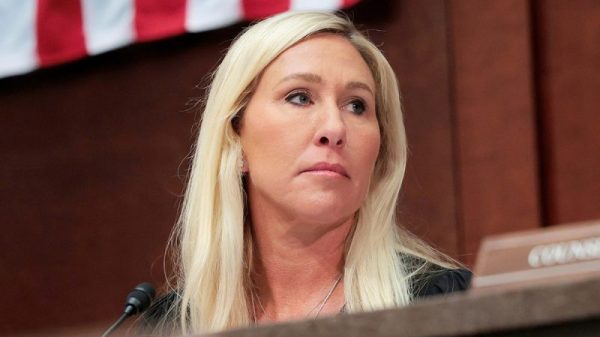When former president Donald Trump’s media start-up announced in October 2021 that it planned to merge with a Miami-based company called Digital World Acquisition, the deal was an instant stock-market hit.
With the $300 million Digital World had already raised from investors, Trump Media & Technology Group, creator of the pro-Trump social network Truth Social, pledged then that the merger would create a tech titan worth $875 million at the start and, depending on the stock’s performance, up to $1.7 billion later.
All they needed was for the merger to close — a process that Digital World, in a July 2021 preliminary prospectus, estimated would happen within 12 to 18 months.
“Everyone asks me why doesn’t someone stand up to Big Tech? Well, we will be soon!” Trump said in a Trump Media statement that month.
Now, almost two years later, the deal faces what could be a catastrophic threat. With the merger stalled for months, Digital World is fast approaching a Sept. 8 deadline for the merger to close and has scheduled a shareholder vote for Tuesday to extend the deadline another year.
If the vote fails, Digital World will be required by law to liquidate and return $300 million to its shareholders, leaving Trump’s company with nothing from the transaction.
For Digital World, it would signal the ultimate financial fall from grace for a special purpose acquisition company, or SPAC, that turned its proximity to the former president into what was once one of the stock market’s hottest trades. Its share price, which peaked in its first hours at $175, has since fallen to about $14.
Digital World’s efforts to merge with Trump Media have been troubled almost from the start, beset by allegations that it began its conversations with the former president’s company before they were permitted under SPAC rules.
Then, in the past year, its issues became more pronounced: Its chief executive was terminated by the board, a former board member was arrested on charges of insider trading, and the company agreed to pay an $18 million settlement to resolve charges that it had misled investors and given false information to the Securities and Exchange Commission.
The merger has “been pretty much unprecedented in terms of all of the glitches,” said Jay Ritter, a University of Florida finance professor who studies stock markets. “The deal does seem to be running out of time. You can’t just keep getting extensions forever.”
The Washington Post provided a detailed outline of its reporting for this article to Digital World and Trump Media.
Shannon Devine, a spokeswoman for Trump Media, which has sued The Post in an ongoing lawsuit for defamation over its past coverage of the merger, said in a statement, “Having repeatedly defamed TMTG with false accusations that it still hasn’t retracted, The Washington Post adds to its heaping pile of bias with this new collection of defamatory and self-refuting falsehoods, proving once again why it’s a terrible mistake for anyone to believe a word they read in this publication.”
The statement did not single out any specific inaccuracy in this story, but Trump Media has alleged in its lawsuit that The Post previously erroneously reported that Trump Media paid a finder’s fee for a loan it received to a company that Digital World’s previous CEO had an interest in.
The SEC declined to comment.
SPACs are known as “blank check” companies because they raise money from investors to buy a private company before identifying who they intend to target. Once the SPAC decides on and discloses its target, it works to merge with that company and bring it to the public stock market, avoiding some of the demands of a more traditional initial public offering, or IPO.
If the SPAC is unable to complete the merger within the time it specifies, it must return the money it raised to shareholders.
Digital World completed its IPO on Sept. 8, 2021, and set a “termination date” for when the merger would be completed one year later, it said in SEC filings. Then, last August, Digital World said in a filing that the board believed it did not have sufficient time to complete the merger and asked shareholders to approve up to four three-months extensions.
Digital World’s leaders then staged an intense get-out-the-vote campaign, postponing shareholder meetings six times as they worked to secure enough investor support. After drawing on millions of dollars in funding from its corporate sponsor, ARC Global Investments II, the company was ultimately able to extend its deadline to Sept. 8 of this year.
Digital World needs 65 percent of the shares held by its nearly 400,000 investors to vote “yes” on the deadline extension; unvoted shares are counted as “no” votes. If the extension fails, Digital World said in a filing in July that it would “cease all operations except for the purpose of winding up” and repay investors at a price of about $10.24 per share — far below what many shareholders paid.
Deadline-extension votes like these are almost always approved because SPAC shares usually are bought by professional or institutional investors who closely track how a deal unfolds, Ritter said.
But Digital World’s shareholder base is made up largely of small-time “retail” investors, making it harder for the company to boost shareholder participation in critical votes. Ritter said he suspects these investors, many of whom bought shares out of love for Trump or loyalty to his brand, may not be paying attention as the liquidation deadline approaches.
Trump Media has blamed the SEC for the deal’s troubles, saying in a statement last year that the agency had worked to “sabotage” the merger for political reasons with “a bureaucratic black hole of inaction.”
But the SEC, which requires SPACs to meet disclosure requirements and other closing conditions before permitting a merger, said in July that it had investigated Digital World and found it had made “material misrepresentations” to investors.
In filings dating back to its September 2021 IPO, Digital World executives said they had not participated in merger discussions with any companies when in fact they’d started speaking with Trump Media leaders months earlier, in violation of federal antifraud guidelines, the SEC said in the statement.
In agreeing to pay an $18 million settlement over its false statements if the merger closes, Digital World said it would revise its registration statement, known as a Form S-4, to correct inaccuracies. The company has yet to resubmit that revised document, SEC filings show.
In a separate filing, Digital World said it also was not ready to file two required quarterly financial reports covering the first half of this year, saying it could not complete them in time without “unreasonable effort or expense.” It has sparred with its former auditors in SEC filings and letters over who is to blame for missing information.
Digital World also is late in filing two required quarterly financial reports with the Nasdaq stock exchange, the company said, adding that Nasdaq has given the company until November to file the reports or risk being delisted.
In a flurry of notices to shareholders, the company has pushed investors to vote to stave off liquidation. “Time is Running Out. Don’t Delay,” one mailer said, in underlined font. “DO NOT THROW THIS AWAY.”
Digital World’s chief executive, Eric Swider, said in a statement to The Post that most of this article’s reporting was “inaccurate or wildly misleading” but offered only four specific responses, arguing that the idea that the deal is on the edge of catastrophe is “nowhere near the truth”; that the company does not “look for ‘hype,’” and that he disputed the existence of a quote attributed to him in a company statement as well as the meaning of one of his Truth Social posts.
Swider has in recent days posted “URGENT!!” messages on Truth Social imploring shareholders to vote. In one post, he wrote, “As the Democrats will tell you; management says vote early, vote often. Bring all of your friends with you.” Swider told The Post the quote “had nothing to do with” Digital World. The post was written three days after Digital World postponed its last shareholder meeting with an official filing that quoted Swider as saying, “Our SPAC is at a defining crossroads.”
In another company statement on Aug. 22, Swider was quoted saying, “A vote for the Extension is a vote for freedom of speech.” When told The Post intended to include the quote in this story, Swider said in an email, “I do not believe this is accurate.” Days before the shareholder vote, the statement remained online.
Trump, who would retain his 90 percent ownership of Trump Media if the deal falls apart, has yet to make mention of the shareholder vote on his own Truth Social account.
Truth Social has attracted a relatively meager following. Though Trump Media projected in a 2021 investor presentation that the site would have 41 million total users by the end of this year, usage estimates from Similarweb, a data firm that analyzes web traffic, suggest it is a long way from reaching that goal.
According to Similarweb estimates, roughly 500,000 monthly active users in the United States visited Truth Social via its Apple and Android mobile apps in July, down from 600,000 in June.
Similarweb’s estimate of how many people in the United States visited Truth Social in July from either a desktop computer or their phone’s web browser totaled just over 1 million, down nearly 20 percent since June. (There is some overlap, given that users can access the site on both their desktops and phones.) Three times as many unique visitors in July visited the websites for The Old Farmer’s Almanac and the Denver Gazette, Similarweb estimates show.
Trump Media also has yet to unveil any of the other offerings it promoted in 2021, such as a subscription video service, TMTG+, that would feature “non-woke” entertainment. In campaign financial filings, Trump has placed the company’s value at between $5 million and $25 million.
In recent weeks, Trump has used Truth Social to hammer some of the public officials connected to his four criminal indictments.
The site has missed out on some opportunities for promotion, however. When Trump sat for an interview with the former Fox News host Tucker Carlson scheduled to counter the Republican primary debate, the video aired not on Trump’s own social network but on X, formerly known as Twitter.
Ep. 19 Debate Night with Donald J Trump pic.twitter.com/ayPfII48CO
— Tucker Carlson (@TuckerCarlson) August 24, 2023
Trump had told his advisers he didn’t want the video to land on a Truth Social competitor, but Carlson’s team argued that Trump’s platform didn’t have the necessary reach, people familiar with the negotiations told The Washington Post.
Truth Social’s main point of distinction — its exclusivity to Trump’s online musings — could face its own threat. On Aug. 24, after surrendering at an Atlanta jail on felony charges alleging he participated in a criminal conspiracy to overturn his 2020 election loss, Trump posted his first tweet in more than two years, including his mug shot.
On Truth Social, some users expressed frustration at what they argued was a betrayal of their pro-Trump corner of the web. One user, with the handle “45MAGA2022,” posted on Truth Social the night the interview aired, “How is this Tweet remotely beneficial to” the merger deal “and/or beneficial to #Truth?”
Trump, however, said he isn’t going anywhere and that Truth Social was his “home.” In a post there Monday, he wrote, “TRUTH SOCIAL IS THE GREATEST & ‘HOTTEST’ FORM, SYSTEM, & PLATFORM OF COMMUNICATION IN AMERICA, & INDEED THE WORLD, TODAY. THAT’S WHY I USE IT — THERE IS NOTHING THAT COMES EVEN CLOSE!!!”
When former president Donald Trump’s media start-up announced in October 2021 that it planned to merge with a Miami-based company called Digital World Acquisition, the deal was an instant stock-market hit.
With the $300 million Digital World had already raised from investors, Trump Media & Technology Group, creator of the pro-Trump social network Truth Social, pledged then that the merger would create a tech titan worth $875 million at the start and, depending on the stock’s performance, up to $1.7 billion later.
All they needed was for the merger to close — a process that Digital World, in a July 2021 preliminary prospectus, estimated would happen within 12 to 18 months.
“Everyone asks me why doesn’t someone stand up to Big Tech? Well, we will be soon!” Trump said in a Trump Media statement that month.
Now, almost two years later, the deal faces what could be a catastrophic threat. With the merger stalled for months, Digital World is fast approaching a Sept. 8 deadline for the merger to close and has scheduled a shareholder vote for Tuesday to extend the deadline another year.
If the vote fails, Digital World will be required by law to liquidate and return $300 million to its shareholders, leaving Trump’s company with nothing from the transaction.
For Digital World, it would signal the ultimate financial fall from grace for a special purpose acquisition company, or SPAC, that turned its proximity to the former president into what was once one of the stock market’s hottest trades. Its share price, which peaked in its first hours at $175, has since fallen to about $14.
Digital World’s efforts to merge with Trump Media have been troubled almost from the start, beset by allegations that it began its conversations with the former president’s company before they were permitted under SPAC rules.
Then, in the past year, its issues became more pronounced: Its chief executive was terminated by the board, a former board member was arrested on charges of insider trading, and the company agreed to pay an $18 million settlement to resolve charges that it had misled investors and given false information to the Securities and Exchange Commission.
The merger has “been pretty much unprecedented in terms of all of the glitches,” said Jay Ritter, a University of Florida finance professor who studies stock markets. “The deal does seem to be running out of time. You can’t just keep getting extensions forever.”
The Washington Post provided a detailed outline of its reporting for this article to Digital World and Trump Media.
Shannon Devine, a spokeswoman for Trump Media, which has sued The Post in an ongoing lawsuit for defamation over its past coverage of the merger, said in a statement, “Having repeatedly defamed TMTG with false accusations that it still hasn’t retracted, The Washington Post adds to its heaping pile of bias with this new collection of defamatory and self-refuting falsehoods, proving once again why it’s a terrible mistake for anyone to believe a word they read in this publication.”
The statement did not single out any specific inaccuracy in this story, but Trump Media has alleged in its lawsuit that The Post previously erroneously reported that Trump Media paid a finder’s fee for a loan it received to a company that Digital World’s previous CEO had an interest in.
The SEC declined to comment.
SPACs are known as “blank check” companies because they raise money from investors to buy a private company before identifying who they intend to target. Once the SPAC decides on and discloses its target, it works to merge with that company and bring it to the public stock market, avoiding some of the demands of a more traditional initial public offering, or IPO.
If the SPAC is unable to complete the merger within the time it specifies, it must return the money it raised to shareholders.
Digital World completed its IPO on Sept. 8, 2021, and set a “termination date” for when the merger would be completed one year later, it said in SEC filings. Then, last August, Digital World said in a filing that the board believed it did not have sufficient time to complete the merger and asked shareholders to approve up to four three-months extensions.
Digital World’s leaders then staged an intense get-out-the-vote campaign, postponing shareholder meetings six times as they worked to secure enough investor support. After drawing on millions of dollars in funding from its corporate sponsor, ARC Global Investments II, the company was ultimately able to extend its deadline to Sept. 8 of this year.
Digital World needs 65 percent of the shares held by its nearly 400,000 investors to vote “yes” on the deadline extension; unvoted shares are counted as “no” votes. If the extension fails, Digital World said in a filing in July that it would “cease all operations except for the purpose of winding up” and repay investors at a price of about $10.24 per share — far below what many shareholders paid.
Deadline-extension votes like these are almost always approved because SPAC shares usually are bought by professional or institutional investors who closely track how a deal unfolds, Ritter said.
But Digital World’s shareholder base is made up largely of small-time “retail” investors, making it harder for the company to boost shareholder participation in critical votes. Ritter said he suspects these investors, many of whom bought shares out of love for Trump or loyalty to his brand, may not be paying attention as the liquidation deadline approaches.
Trump Media has blamed the SEC for the deal’s troubles, saying in a statement last year that the agency had worked to “sabotage” the merger for political reasons with “a bureaucratic black hole of inaction.”
But the SEC, which requires SPACs to meet disclosure requirements and other closing conditions before permitting a merger, said in July that it had investigated Digital World and found it had made “material misrepresentations” to investors.
In filings dating back to its September 2021 IPO, Digital World executives said they had not participated in merger discussions with any companies when in fact they’d started speaking with Trump Media leaders months earlier, in violation of federal antifraud guidelines, the SEC said in the statement.
In agreeing to pay an $18 million settlement over its false statements if the merger closes, Digital World said it would revise its registration statement, known as a Form S-4, to correct inaccuracies. The company has yet to resubmit that revised document, SEC filings show.
In a separate filing, Digital World said it also was not ready to file two required quarterly financial reports covering the first half of this year, saying it could not complete them in time without “unreasonable effort or expense.” It has sparred with its former auditors in SEC filings and letters over who is to blame for missing information.
Digital World also is late in filing two required quarterly financial reports with the Nasdaq stock exchange, the company said, adding that Nasdaq has given the company until November to file the reports or risk being delisted.
In a flurry of notices to shareholders, the company has pushed investors to vote to stave off liquidation. “Time is Running Out. Don’t Delay,” one mailer said, in underlined font. “DO NOT THROW THIS AWAY.”
Digital World’s chief executive, Eric Swider, said in a statement to The Post that most of this article’s reporting was “inaccurate or wildly misleading” but offered only four specific responses, arguing that the idea that the deal is on the edge of catastrophe is “nowhere near the truth”; that the company does not “look for ‘hype,’” and that he disputed the existence of a quote attributed to him in a company statement as well as the meaning of one of his Truth Social posts.
Swider has in recent days posted “URGENT!!” messages on Truth Social imploring shareholders to vote. In one post, he wrote, “As the Democrats will tell you; management says vote early, vote often. Bring all of your friends with you.” Swider told The Post the quote “had nothing to do with” Digital World. The post was written three days after Digital World postponed its last shareholder meeting with an official filing that quoted Swider as saying, “Our SPAC is at a defining crossroads.”
In another company statement on Aug. 22, Swider was quoted saying, “A vote for the Extension is a vote for freedom of speech.” When told The Post intended to include the quote in this story, Swider said in an email, “I do not believe this is accurate.” Days before the shareholder vote, the statement remained online.
Trump, who would retain his 90 percent ownership of Trump Media if the deal falls apart, has yet to make mention of the shareholder vote on his own Truth Social account.
Truth Social has attracted a relatively meager following. Though Trump Media projected in a 2021 investor presentation that the site would have 41 million total users by the end of this year, usage estimates from Similarweb, a data firm that analyzes web traffic, suggest it is a long way from reaching that goal.
According to Similarweb estimates, roughly 500,000 monthly active users in the United States visited Truth Social via its Apple and Android mobile apps in July, down from 600,000 in June.
Similarweb’s estimate of how many people in the United States visited Truth Social in July from either a desktop computer or their phone’s web browser totaled just over 1 million, down nearly 20 percent since June. (There is some overlap, given that users can access the site on both their desktops and phones.) Three times as many unique visitors in July visited the websites for The Old Farmer’s Almanac and the Denver Gazette, Similarweb estimates show.
Trump Media also has yet to unveil any of the other offerings it promoted in 2021, such as a subscription video service, TMTG+, that would feature “non-woke” entertainment. In campaign financial filings, Trump has placed the company’s value at between $5 million and $25 million.
In recent weeks, Trump has used Truth Social to hammer some of the public officials connected to his four criminal indictments.
The site has missed out on some opportunities for promotion, however. When Trump sat for an interview with the former Fox News host Tucker Carlson scheduled to counter the Republican primary debate, the video aired not on Trump’s own social network but on X, formerly known as Twitter.
Ep. 19 Debate Night with Donald J Trump pic.twitter.com/ayPfII48CO
— Tucker Carlson (@TuckerCarlson) August 24, 2023
Trump had told his advisers he didn’t want the video to land on a Truth Social competitor, but Carlson’s team argued that Trump’s platform didn’t have the necessary reach, people familiar with the negotiations told The Washington Post.
Truth Social’s main point of distinction — its exclusivity to Trump’s online musings — could face its own threat. On Aug. 24, after surrendering at an Atlanta jail on felony charges alleging he participated in a criminal conspiracy to overturn his 2020 election loss, Trump posted his first tweet in more than two years, including his mug shot.
On Truth Social, some users expressed frustration at what they argued was a betrayal of their pro-Trump corner of the web. One user, with the handle “45MAGA2022,” posted on Truth Social the night the interview aired, “How is this Tweet remotely beneficial to” the merger deal “and/or beneficial to #Truth?”
Trump, however, said he isn’t going anywhere and that Truth Social was his “home.” In a post there Monday, he wrote, “TRUTH SOCIAL IS THE GREATEST & ‘HOTTEST’ FORM, SYSTEM, & PLATFORM OF COMMUNICATION IN AMERICA, & INDEED THE WORLD, TODAY. THAT’S WHY I USE IT — THERE IS NOTHING THAT COMES EVEN CLOSE!!!”





















